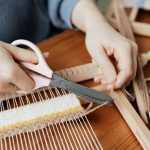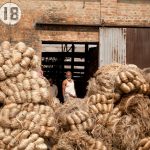To find abaca fiber buyers, focus on key markets like textiles, handicrafts, and paper industries. Use online platforms such as Alibaba and TradeKey to reach global clients, and join local cooperatives for trusted contacts. Maintain strict quality control by harvesting mature fibers, removing impurities, and ensuring consistent batches. Building long-term relationships with exporters and offering flexible terms will boost trust and sales. Keep these strategies in mind, and you’ll discover more ways to connect with reliable buyers.
Table of Contents
Key Takeaways
- Identify key buyers like textile manufacturers, handicraft producers, paper industry, and exporters for targeted marketing of abaca fiber.
- Use online B2B platforms such as Alibaba, TradeKey, and Global Sources to reach bulk buyers globally.
- Emphasize quality, sustainability, and consistent fiber grading in listings to attract serious and premium buyers.
- Maintain rigorous quality assurance by harvesting, cleaning, drying, and storing fibers properly to ensure uniformity and strength.
- Build trust through transparent negotiations, flexible terms, and regular communication to establish long-term buyer partnerships.
Understanding the Abaca Fiber Market in the Philippines
Although the abaca fiber market in the Philippines faces challenges, it remains an important part of the country’s economy.
Despite challenges, the abaca fiber market remains a vital pillar of the Philippine economy.
You’ll find that abaca, also known as Manila hemp, is prized for its strength and durability, making it vital in industries like rope-making, textiles, and handicrafts.
The Philippines supplies most of the world’s abaca fiber, so understanding local market dynamics helps you position your products effectively.
You need to keep an eye on factors such as weather impacts, pest infestations, and fluctuating prices that can affect production and sales.
Staying informed about government support programs and export regulations will also give you an advantage.
Identifying Key Buyers and Market Segments
To successfully sell your abaca fiber, you need to know who your buyers are and which market segments offer the best opportunities. Key buyers include manufacturers of textiles, handicrafts, and paper products. Understanding these segments helps you tailor your product quality and quantity accordingly.
| Buyer Type | Product Use | Demand Characteristics |
|---|---|---|
| Textile Manufacturers | Fabric and ropes | High volume, consistent quality |
| Handicraft Producers | Bags, mats, decor | Varied volume, focus on texture |
| Paper Industry | Specialty paper | Moderate volume, specific grades |
| Exporters | Global markets | High quality, certifications |
| Local Traders | Domestic distribution | Flexible volume, quick turnover |
Utilizing Online Platforms to Connect With Buyers
You can reach a wider audience by using top online marketplaces tailored for fiber and textile buyers.
Social media networking also helps you build relationships and showcase your abaca fiber products directly.
Start exploring these platforms to connect with serious buyers more efficiently.
Top Online Marketplaces
Anyone looking to sell abaca fiber can tap into a variety of online marketplaces that connect you directly with buyers worldwide.
Platforms like Alibaba, Etsy, and Made-in-China offer global reach, letting you showcase your abaca products to manufacturers, retailers, and wholesalers. These sites provide tools to create detailed listings, manage orders, and receive payments securely.
For bulk buyers, B2B platforms like TradeKey and Global Sources are excellent for establishing long-term partnerships.
Make sure to highlight the quality and sustainability of your abaca fiber in your listings to attract serious buyers. Regularly update your inventory and respond promptly to inquiries to build trust.
Social Media Networking
Beyond online marketplaces, social media platforms offer powerful ways to connect with buyers directly and build lasting relationships.
You can use Facebook, Instagram, and LinkedIn to showcase your abaca fiber products, share your farming process, and highlight quality standards.
Join relevant groups and communities where buyers and industry professionals gather. Engaging regularly through posts, comments, and messages helps you build trust and credibility.
Use targeted hashtags and location tags to increase your visibility to potential buyers both locally and internationally.
Don’t hesitate to run promotions or share customer testimonials to attract interest.
Participating in Industry Trade Shows and Exhibitions
Attending trade shows and exhibitions offers several key opportunities to connect directly with potential abaca fiber buyers.
You get to showcase your fibers, learn about market trends, and build relationships that can lead to sales. These events bring together industry experts, manufacturers, and buyers all in one place, making it easier for you to understand demand and pricing.
When you participate, focus on:
- Setting up a clear, attractive display of your abaca fibers
- Preparing samples to hand out to interested buyers
- Networking actively with attendees and other exhibitors
- Attending workshops to gain insights on market needs
- Collecting contact information for follow-up conversations
Leveraging Local Cooperatives and Associations
Joining local cooperatives can give you access to shared resources and better market reach.
You’ll also build valuable connections through associations that help you find reliable buyers.
Taking advantage of these networks boosts your chances of selling abaca fiber successfully.
Cooperative Membership Benefits
Collaboration opens up many advantages when you become a member of local cooperatives or associations.
Joining one connects you to shared resources and collective bargaining power, making it easier to sell your abaca fiber at better prices. You’ll access training programs that improve your skills and product quality.
Plus, cooperatives often provide financial support or credit options, helping you invest in your farm or production processes. Membership also means you can participate in decision-making, influencing policies that benefit your community and business.
Here are some key benefits you’ll enjoy:
- Collective buying power for supplies and equipment
- Access to market information and trends
- Training and capacity-building workshops
- Financial aid and credit facilities
- Voice in cooperative governance and policies
Networking Through Associations
Being part of local cooperatives not only grants you access to resources but also opens doors to valuable connections within the abaca fiber industry.
By actively engaging with these groups, you can meet seasoned farmers, buyers, and exporters who know the market well. Attending association meetings and events helps you stay updated on industry trends and pricing, giving you a competitive edge.
You’ll find opportunities to collaborate on bulk sales, negotiate better terms, and even tap into government programs supporting abaca producers.
Plus, associations often have established networks with international buyers, making it easier for you to reach markets beyond your locality. Leveraging these connections can greatly boost your chances of finding reliable buyers for your abaca fiber.
Building Relationships With Exporters and Processors
When you connect directly with exporters and processors, you open doors to consistent demand and valuable market insights. Building strong relationships means more than just sales—it’s about trust and collaboration.
Keep communication clear and timely, so they see you as reliable. Understand their quality standards and delivery schedules to meet expectations. Be open to feedback and willing to adjust your practices accordingly.
Here’s how to nurture these connections:
- Schedule regular check-ins to discuss needs and updates
- Share samples and updates about your fiber quality
- Attend trade shows or industry events together
- Offer transparency about your production capacity
- Collaborate on solving supply chain challenges
These steps help you grow partnerships that benefit both sides.
Pricing Strategies and Negotiation Tips
Although securing buyers is essential, mastering pricing strategies and negotiation skills can make or break your success in the abaca fiber market.
Start by researching current market prices to set a competitive yet profitable rate. Know your costs well—this helps you avoid selling below your break-even point.
When negotiating, listen carefully to buyers’ needs and be ready to highlight the value of your fiber. Don’t hesitate to propose flexible terms, like volume discounts or payment schedules, to close deals.
Stay confident but open to compromise; building trust often leads to long-term partnerships. Ultimately, document agreements clearly to prevent misunderstandings.
Ensuring Quality Standards to Attract Premium Buyers
Since premium buyers prioritize quality, you need to maintain strict standards for your abaca fiber to stand out.
Premium buyers value quality, so uphold rigorous standards to differentiate your abaca fiber in the market.
Focus on producing fibers that are clean, uniform, and strong to meet their expectations. Consistency is key, so establish quality checks at every stage—from harvesting to drying and packaging. Use proper handling techniques to avoid contamination or damage. Meeting recognized certifications or industry standards can also boost your credibility and attract top buyers.
Here are essential practices to guarantee quality:
- Harvest fibers at the right maturity for ideal strength
- Remove impurities and foreign materials carefully
- Dry fibers under controlled conditions to prevent mildew
- Store fibers in a clean, dry environment
- Regularly inspect fiber batches for uniformity and defects
Frequently Asked Questions
What Are the Environmental Benefits of Cultivating Abaca Fiber?
You’ll help reduce soil erosion and improve biodiversity by cultivating abaca fiber. It requires fewer chemicals, conserves water, and absorbs carbon dioxide, making your farming more sustainable and better for the environment overall.
How Long Does It Take for Abaca Plants to Mature?
You won’t believe it, but abaca plants mature surprisingly fast! Usually, it takes about 9 to 12 months for them to be ready for harvesting. So, you won’t have to wait forever to reap the benefits!
What Are Common Pests Affecting Abaca Crops?
You’ll often face pests like the abaca bunchy top virus, shoot borers, and aphids. These pests damage your plants by stunting growth and spreading diseases, so you’ll need to monitor and manage them carefully.
Can Abaca Fiber Be Blended With Other Natural Fibers?
Yes, you can blend abaca fiber with other natural fibers like cotton, hemp, or jute to create stronger, more flexible textiles. Blending enhances durability and texture, making your products more versatile and appealing to different markets.
What Are the Best Storage Practices for Harvested Abaca Fiber?
You should keep harvested abaca fiber dry and well-ventilated to prevent mold. Store it off the ground, away from direct sunlight, and avoid compressing the fibers to maintain their quality and strength over time.
- Does Chiffon Fabric Stink - July 15, 2025
- Does Chiffon Fabric Affect the Economy - July 15, 2025
- Does Cotton Fabric Have a Nap - July 15, 2025







